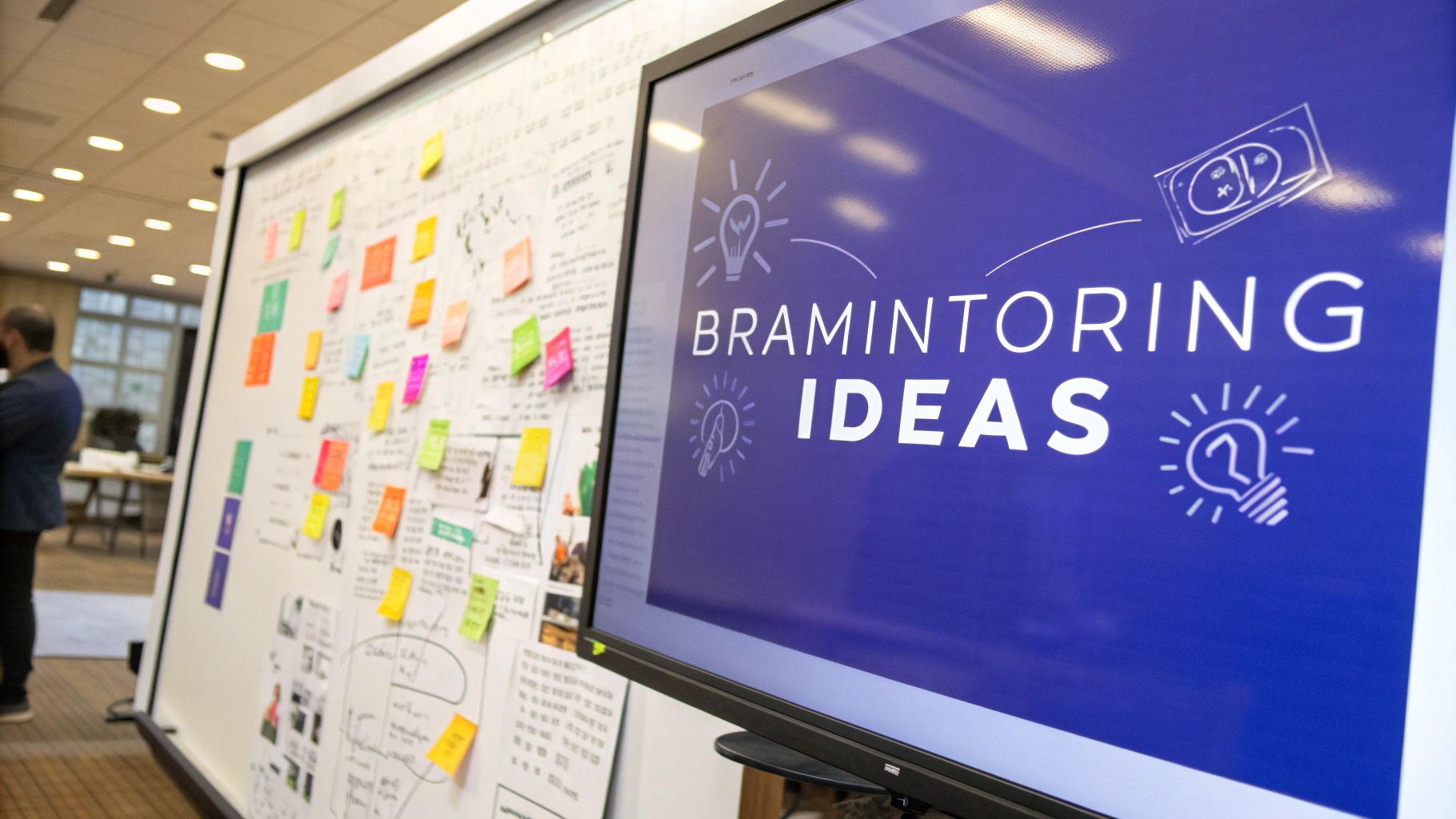15 Proven Remote Teams Activities That Build Genuine Connection
The Real Impact of Remote Teams Activities

As more companies embrace remote work, team activities have become essential for building strong virtual workplaces. These activities directly affect key areas like communication, collaboration, employee engagement, and team wellbeing. When organizations thoughtfully invest in remote team building, they're not just providing entertainment - they're addressing fundamental business needs that impact their bottom line.
Boosting Engagement and Morale Through Connection
Remote workers often struggle with feelings of isolation and disconnection from their colleagues, which can affect their motivation and engagement. Well-designed team activities help solve these challenges by creating opportunities for meaningful social interaction and strengthening relationships between team members. Research shows that while over 80% of employers and employees recognize how important workplace community is, many companies still aren't taking simple steps to build it through regular activities.
Enhancing Communication and Collaboration in Remote Teams
Team activities also play a key role in improving how remote teams communicate and work together. Interactive experiences like virtual escape rooms and online team games help break down barriers between colleagues and build genuine rapport. As team members become more comfortable with each other, their day-to-day work communication improves naturally. Studies from 2009 show that when virtual teams have strong mutual support and coordination, they can perform even better than in-person teams.
Measuring the ROI of Remote Teams Activities
To understand if team activities are truly effective, organizations need to look beyond basic metrics like attendance. The real impact shows up in concrete improvements to team performance - for example, faster project completion times, fewer communication mistakes, and higher employee satisfaction scores. Using data to evaluate activities helps companies fine-tune their approach and invest in what actually works for their teams.
From One-Off Events to Ongoing Engagement
The most successful remote teams make engagement an ongoing priority rather than relying on occasional events. Like tending a garden, building strong remote teams requires consistent care and attention over time. This means creating a varied program of activities - from casual virtual coffee chats to skill-building workshops - and regularly assessing what resonates with the team. The goal is to make these activities a natural part of remote work culture, helping distributed teams stay connected and collaborative despite physical distance.
Building Authentic Cultural Connections Virtually

Creating meaningful connections in remote teams requires going beyond basic virtual gatherings. Rather than just scheduling routine online meetings, focus on designing shared experiences that bring people together naturally. For instance, instead of playing a generic online game, organize a virtual escape room based on an inside joke or team project that reflects your group's personality. This helps build a shared story and strengthens how team members relate to each other. Well-planned remote activities tap into our fundamental need to feel connected and part of something larger.
Understanding the Psychology of Virtual Connection
When building relationships remotely, it's important to recognize the unique challenges of distance. Virtual interactions lack many subtle social cues we rely on in person, like body language and spontaneous conversations. This can lead to misunderstandings and feelings of isolation. That's why remote team activities need careful planning to bridge these gaps. For teams spread across different time zones and countries, traditional group activities may not work well. More flexible options like shared playlists or collaborative storytelling projects allow everyone to participate in ways that fit their schedule.
Activities That Foster Cultural Exchange
Sharing cultural perspectives helps remote teams develop empathy and understanding. Simple activities like "virtual coffee roulette" - where team members are randomly paired for casual chats - give people chances to connect personally and learn about each other's backgrounds. Another effective approach is having team members share elements of their culture, from favorite recipes to local traditions and customs. This turns cultural differences into opportunities to learn from each other and build stronger bonds. Through these exchanges, remote teams can create an environment where everyone feels included and valued.
Overcoming Virtual Collaboration Barriers
One major challenge in virtual teams is the lack of natural, unplanned interactions. Combat this by creating spaces for casual conversation, like dedicated chat channels for non-work topics or virtual coffee breaks. However, avoid making social activities feel forced or mandatory. The goal is providing opportunities for organic connections rather than required participation. Since team members have different preferences for engaging virtually, offer various activity options. While some may enjoy competitive games, others might prefer book clubs or group yoga sessions. You might be interested in: Proven virtual team building activities to transform remote teams. Having diverse choices ensures everyone can find comfortable ways to connect with colleagues.
Maximizing Technology for Meaningful Connection
Many remote teams find video meetings draining, but there are better ways to use technology for building real connections. The key is to move beyond basic video calls and explore the full potential of both real-time and asynchronous collaboration tools. When used thoughtfully, these tools can create engaging shared experiences that bring teams together.
Rethinking Virtual Meetings for Deeper Engagement
Standard video meetings often feel flat and one-dimensional. However, with some creative thinking, these same meetings can become lively spaces for team building. For instance, starting with a quick icebreaker question gets everyone involved from the start and sets an interactive tone. Adding visual collaboration through tools like Miro during brainstorming sessions helps teammates contribute ideas more naturally and builds stronger connections through shared creation.
Embracing Asynchronous Activities for Flexibility and Inclusion
Team activities that don't require everyone to be online at the same time work especially well for global teams across time zones. This approach lets people participate when it works best for them, making activities more inclusive and less stressful than real-time meetings. Some effective examples include:
- Collaborative Storytelling: Team members take turns adding to an ongoing story, building connections through creative writing.
- Shared Playlists or Book Clubs: Bonding over music or books gives teammates ways to connect around shared interests beyond work.
- Online Team Challenges: Platforms like TeamCheck offer engaging activities from virtual escape rooms to wellness challenges that people can complete on their own schedule.
Choosing the Right Tech Tools for Your Team's Needs
Finding tools that truly fit your team is crucial for successful virtual team building. Match the tools to your specific goals and team preferences. For day-to-day communication, platforms like Slack or Microsoft Teams work well, especially when enhanced with interactive add-ons. For structured team activities like online games, specialized platforms often provide a better experience. With remote work growing steadily - expected to include 25% of North American professionals by the end of 2023 - choosing the right tools becomes increasingly important.
Avoiding Common Pitfalls and Measuring Success
While technology offers many ways to connect teams, it's important to avoid common mistakes. Too many video meetings can overwhelm people, so mix in asynchronous activities to prevent burnout. Remember that team building should serve clear goals around improving communication and collaboration. Track the impact through employee surveys and team performance metrics to show the value and keep improving your approach. When used thoughtfully, technology becomes a powerful tool for building strong remote team relationships.
Creating Engagement That Overcomes Distance

Remote work has fundamentally changed how teams connect and collaborate. While digital tools enable us to work from anywhere, maintaining strong team bonds across physical distances requires thoughtful effort and planning. Well-designed remote activities play a vital role in fighting isolation, lifting spirits, and helping distributed teams work better together.
Designing Activities With Purpose
The success of remote team activities depends on understanding what truly motivates people to participate. Simply scheduling required virtual meetings often leads to video call burnout and frustration. Instead, focus on activities that offer real value and appeal to different interests and personalities. This helps teams build authentic relationships rather than just going through the motions.
Balancing Structure and Spontaneity
Creating engaged remote teams requires both planned activities and casual social time. Organized team building like virtual escape rooms or online games provides clear goals and encourages participation. At the same time, offering spaces for informal interaction through virtual coffee chats or social channels allows relationships to develop naturally. This mix ensures remote teams can connect in both structured and relaxed ways.
Fostering Inclusivity Across Time Zones
Working across multiple time zones presents a key challenge for remote teams. Asynchronous activities offer an effective solution by letting team members participate when it works best for them. This flexibility ensures everyone can join in, regardless of location. For example, collaborative storytelling projects, team playlists, or online challenges work well across different schedules while still building connections.
Examples of Engaging Remote Teams Activities
Here are some proven remote team activities that put these principles into practice:
| Activity Type | Description | Benefits |
|---|---|---|
| Virtual Escape Room | Teams work together to solve puzzles and escape a virtual scenario. | Promotes problem-solving, communication, and teamwork. |
| Online Team Games | Engaging in friendly competition through online games. | Builds camaraderie and encourages lighthearted interaction. |
| Virtual Coffee Breaks | Informal video chats between team members. | Fosters casual conversation and strengthens personal connections. |
| Collaborative Storytelling | Team members contribute to a shared story over time. | Encourages creativity and builds a sense of shared experience. |
| Shared Playlists/Book Clubs | Connecting over shared interests in music or literature. | Provides a platform for informal discussion and bonding outside of work. |
By offering diverse activities like these, companies can build strong remote teams where people feel connected and supported. This leads directly to better communication, closer collaboration, and higher productivity across the organization.
Measuring Virtual Team Building Success
Building strong remote teams takes more than just counting who shows up to virtual activities. While participation matters, the real impact comes from seeing positive changes across your organization. To understand if your team building efforts work, you need to look at multiple measures and collect honest feedback from your team.
Key Performance Indicators (KPIs) for Remote Teams
To see if your team activities make a difference, pick metrics that match what you want to achieve. For instance, if better communication is your goal, track how often team members connect and whether messages are getting across clearly. If you're focused on collaboration, look at how quickly projects get done and how smoothly teams work together. Other important things to measure include:
- Employee Satisfaction and Morale: Use quick surveys to check how the team is feeling and spot any isolation or disconnection. This helps you understand what's bothering people so you can plan better activities.
- Collaboration Effectiveness: Watch how well teams complete projects together. Are tasks moving along smoothly? Are there fewer delays? Better teamwork shows up in these areas.
- Communication Quality: Look for clearer messages and fewer misunderstandings. When team members share information better and have fewer conflicts, it shows your team building is working.
- Innovation and Creativity: Check if people are sharing more new ideas and finding creative solutions. Good team activities often lead to more brainstorming and fresh thinking.
Gathering Feedback and Iterating Your Approach
Getting regular feedback helps you keep improving your team activities. Use both numbers and stories - surveys give you data, while conversations reveal details about what people really think. Anonymous feedback forms let people be honest about what they like and don't like. Team discussions after activities show which parts worked best and what needs fixing. Keep adjusting as your team grows and changes. Learn more in our article about How to master workplace culture improvements.
Tools and Frameworks for Measurement
Many tools can help track how well your team building works. Some platforms show you who joins in and how engaged they are. You might also use project tools to see how well people work together, or check communication patterns in your team chat. Set up a simple way to collect and review this information regularly. This helps you see what you're getting from your team activities and plan better ones.
From Metrics to Meaningful Impact
While numbers are helpful, remember that building strong teams is about people. Your main goal is creating a workplace where everyone feels connected and motivated to do their best work. Along with tracking metrics, pay attention to how people interact day to day. Notice when team members seem more friendly, happier, or more willing to help each other. These real-life observations tell you if your team building efforts are truly making work better for everyone.
Building Sustainable Remote Connection Programs

Creating lasting connections in remote teams requires more than just random activities - it needs a thoughtful, systematic approach. Rather than planning one-off virtual events, successful companies build ongoing programs that keep teams engaged throughout the year. For instance, instead of hosting a single team-building session, you might create a mix of activities like monthly game nights, weekly coffee chats, and quarterly challenges that cater to different interests. This steady cadence helps make team bonding a natural part of your remote culture.
Designing a Balanced Activity Calendar
The key to sustainable remote engagement lies in creating a well-planned activity calendar. Finding the right balance is crucial - too many events can overwhelm your team, while too few can leave people feeling disconnected. A good starting point is to combine casual weekly touchpoints, like virtual coffee breaks, with more structured monthly activities such as online games or collaborative projects. Make sure to include options that work for different personalities and time zones so everyone can participate meaningfully.
Scaling Activities As Your Team Grows
As your remote team expands, your connection program needs to evolve. What works perfectly for ten people often needs adjustment for fifty. For example, simple coffee chats might need to shift into structured small group sessions as your team grows. Consider organizing both team-wide events and smaller group activities to maintain close connections while fostering broader company unity. This flexible approach helps preserve personal connections even as your organization gets bigger.
Budgeting and Resource Allocation for Long-Term Engagement
Building lasting remote connections requires dedicated resources and planning. Set aside specific funds for virtual events, team-building tools, and occasional gifts to show appreciation for participation. For example, you might budget for subscriptions to online game platforms, virtual event hosting services, or care packages for team celebrations. You might be interested in: How to improve workplace culture to master employee engagement. Make sure to assign clear ownership for organizing these initiatives so they stay consistent and well-executed.
Maintaining Program Effectiveness Over Time
Success requires regular check-ins and adjustments to keep your remote connection program fresh and relevant. Pay attention to what activities spark enthusiasm and which ones fall flat. Send out simple surveys after events to gather feedback, track participation trends, and spot opportunities for improvement. Use this input to fine-tune your approach and keep activities aligned with what your team actually enjoys and finds valuable. With ongoing care and adaptation, you can build remote connections that truly strengthen your team and create a vibrant remote work culture.
Ready to build a stronger, more connected remote team? TeamCheck offers AI-powered insights and engaging activities to help your team thrive. Learn more at https://www.teamcheck.ai/.